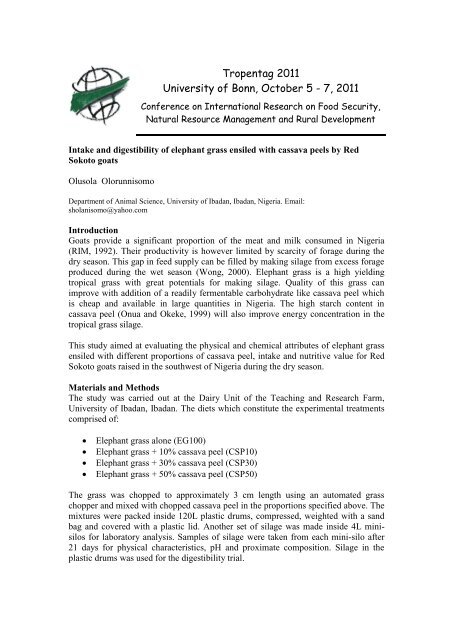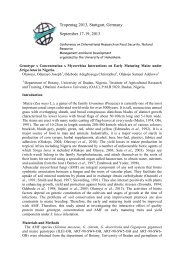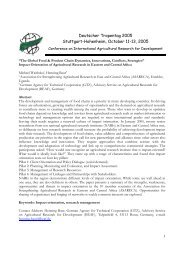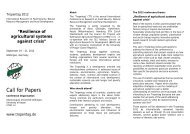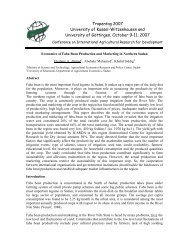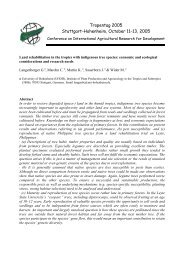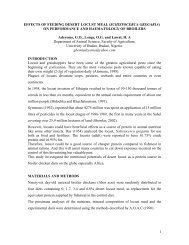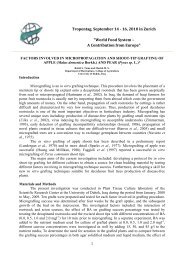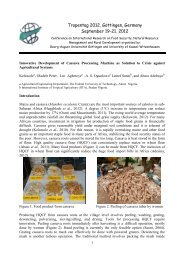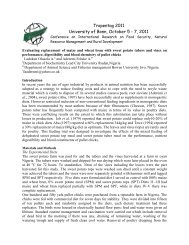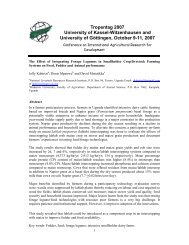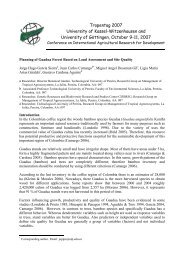Intake and Digestibility of Elephant Grass Ensiled with ... - Tropentag
Intake and Digestibility of Elephant Grass Ensiled with ... - Tropentag
Intake and Digestibility of Elephant Grass Ensiled with ... - Tropentag
Create successful ePaper yourself
Turn your PDF publications into a flip-book with our unique Google optimized e-Paper software.
<strong>Tropentag</strong> 2011University <strong>of</strong> Bonn, October 5 - 7, 2011Conference on International Research on Food Security,Natural Resource Management <strong>and</strong> Rural Development<strong>Intake</strong> <strong>and</strong> digestibility <strong>of</strong> elephant grass ensiled <strong>with</strong> cassava peels by RedSokoto goatsOlusola OlorunnisomoDepartment <strong>of</strong> Animal Science, University <strong>of</strong> Ibadan, Ibadan, Nigeria. Email:sholanisomo@yahoo.comIntroductionGoats provide a significant proportion <strong>of</strong> the meat <strong>and</strong> milk consumed in Nigeria(RIM, 1992). Their productivity is however limited by scarcity <strong>of</strong> forage during thedry season. This gap in feed supply can be filled by making silage from excess forageproduced during the wet season (Wong, 2000). <strong>Elephant</strong> grass is a high yieldingtropical grass <strong>with</strong> great potentials for making silage. Quality <strong>of</strong> this grass canimprove <strong>with</strong> addition <strong>of</strong> a readily fermentable carbohydrate like cassava peel whichis cheap <strong>and</strong> available in large quantities in Nigeria. The high starch content incassava peel (Onua <strong>and</strong> Okeke, 1999) will also improve energy concentration in thetropical grass silage.This study aimed at evaluating the physical <strong>and</strong> chemical attributes <strong>of</strong> elephant grassensiled <strong>with</strong> different proportions <strong>of</strong> cassava peel, intake <strong>and</strong> nutritive value for RedSokoto goats raised in the southwest <strong>of</strong> Nigeria during the dry season.Materials <strong>and</strong> MethodsThe study was carried out at the Dairy Unit <strong>of</strong> the Teaching <strong>and</strong> Research Farm,University <strong>of</strong> Ibadan, Ibadan. The diets which constitute the experimental treatmentscomprised <strong>of</strong>:<strong>Elephant</strong> grass alone (EG100)<strong>Elephant</strong> grass + 10% cassava peel (CSP10)<strong>Elephant</strong> grass + 30% cassava peel (CSP30)<strong>Elephant</strong> grass + 50% cassava peel (CSP50)The grass was chopped to approximately 3 cm length using an automated grasschopper <strong>and</strong> mixed <strong>with</strong> chopped cassava peel in the proportions specified above. Themixtures were packed inside 120L plastic drums, compressed, weighted <strong>with</strong> a s<strong>and</strong>bag <strong>and</strong> covered <strong>with</strong> a plastic lid. Another set <strong>of</strong> silage was made inside 4L minisilosfor laboratory analysis. Samples <strong>of</strong> silage were taken from each mini-silo after21 days for physical characteristics, pH <strong>and</strong> proximate composition. Silage in theplastic drums was used for the digestibility trial.
Twelve Red Sokoto goats (15.4 ± 1.2 kg) were placed inside individual pens <strong>with</strong>slated wooden floors adapted for faecal collection. Animals were <strong>of</strong>feredexperimental diets (silage) ad libitum for 21 days. Animals were adapted to pens <strong>and</strong>feed for 7 days while silage intake was measured in the last 14 days. Fresh water was<strong>of</strong>fered free choice on a daily basis. Total faecal collection was done during the last 7days <strong>and</strong> ten percent <strong>of</strong> faeces collected were taken for proximate analysis. Proximatecomposition <strong>of</strong> the feed <strong>and</strong> faeces were determined by the methods <strong>of</strong> AOAC (1995).The experimental design adopted in this study was the completely r<strong>and</strong>omized design.Data obtained were subjected to analysis <strong>of</strong> variance <strong>and</strong> significant means wereseparated by Duncan’s multiple range tests using the procedures <strong>of</strong> SAS (1995).Results <strong>and</strong> DiscussionThe physical characteristics <strong>and</strong> pH <strong>of</strong> silage mixtures prepared from elephant grass<strong>and</strong> cassava peels are presented in Table 1.Table 1. Physical characteristics <strong>and</strong> pH <strong>of</strong> elephant grass <strong>and</strong> cassava peel silage at 21 days<strong>of</strong> ensilingParameter EG100 CSP10 CSP30 CSP50Appearance Pale green Pale green <strong>with</strong>little brown <strong>and</strong>white specklesLight green <strong>with</strong>many brown <strong>and</strong>white specklesLight green <strong>with</strong>many brown <strong>and</strong>white specklesSmell Pleasant Pleasant Pleasant Very pleasantTextureFirm but slightlywetFirm but slightlywetFirmVery firmpH 4.70 4.56 4.10 3.75EG100: elephant grass alone, CSP10: elephant grass + 10% cassava peel, CSP30: elephant grass + 30%cassava peel, CSP50: elephant grass + 50% cassava peel.Silage <strong>with</strong> higher content <strong>of</strong> cassava peel (CSP30 <strong>and</strong> CSP50) had a lighter greencolour than those <strong>with</strong> little or no cassava peel (EG100 <strong>and</strong> CSP10). All the silagesprepared had a pleasant <strong>and</strong> acceptable smell; however, it appears that the smellimproved <strong>with</strong> increasing level <strong>of</strong> cassava peel in the mixture. All the silages werefirm in texture although those <strong>with</strong> little or no cassava peel were slightly wet whentouched. The pH <strong>of</strong> the silages ranged from 3.75- 4.70. These were <strong>with</strong>in acceptablerange for good silage in the tropics (Bilal, 2009, Nhan et al., 2009). The pH <strong>of</strong> theensiled mixtures reduced <strong>with</strong> increasing level <strong>of</strong> cassava peel inclusion, showing thataddition <strong>of</strong> cassava peel was effective in improving fermentation characteristics <strong>of</strong> thetropical grass silage.Proximate composition <strong>of</strong> the ensiled mixtures is shown in Table 2. DM content <strong>of</strong>the silage increased as the proportion <strong>of</strong> cassava peel in the mixture increased.Although crude protein content in elephant grass silage was slightly higher than thosecontaining cassava peel, all silages had protein content lower than the minimum <strong>of</strong> 6 -
7 % required in ruminant diets for effective rumen function (Milford <strong>and</strong> Haydock,1965), hence goats fed these basal diets will require protein supplementation. Crudefibre content <strong>of</strong> the silage mixtures reduced <strong>with</strong> increasing proportion <strong>of</strong> cassava peelin the silage while nitrogen free extracts (NFE) increased.Table 2. Chemical composition <strong>of</strong> elephant grass <strong>and</strong> cassava peel silageParameter EG100 CSP10 CSP30 CSP50Dry matter 18.36 22.10 25.61 30.03Crude protein 5.50 5.03 4.80 4.52Ether extract 0.86 0.88 0.80 0.79Crude fibre 35.00 34.00 30.80 29.50Ash 7.5 8.00 8.80 8.90Nitrogen free 51.14 51.55 54.80 56.29extractEG100: elephant grass alone, CSP10: elephant grass + 10% cassava peel, CSP30: elephantgrass + 30% cassava peel, CSP50: elephant grass + 50% cassava peel.Dry matter intake <strong>and</strong> nutrient digestibility <strong>of</strong> silage by Red Sokoto goats arepresented in Table 3. Silage intake increased <strong>with</strong> increasing level <strong>of</strong> cassava peel inthe diet, showing that goats preferred silage <strong>with</strong> added cassava peel.Table 3. Dry matter intake <strong>of</strong> Red Sokoto goats <strong>and</strong> nutrient digestibility <strong>of</strong> elephantgrass ensiled <strong>with</strong> cassava peelParameters EG100 CSP10 CSP30 CSP50 SEMForage intake (g/day) 239.04 d 265.07 c 305.83 b 357.55 a 5.26<strong>Intake</strong> (% BW) 2.55 c 2.68 bc 2.92 ab 3.09 a 0.06DM digestibility (%) 54.67 b 56.67 b 64.33 a 68.00 a 6.10CP digestibility (%) 44.00 b 47.67 b 52.67 ab 59.00 a 5.93CF digestibility (%) 54.00 b 54.67 b 62.33 a 63.67 a 5.61abcd means <strong>with</strong> different superscripts <strong>with</strong>in the row are significantly different (P< 0.05)BW: body weight, EG100: elephant grass alone, CSP10: elephant grass + 10% cassava peel,CSP30: elephant grass + 30% cassava peel, CSP50: elephant grass + 50% cassava peel.<strong>Intake</strong> <strong>of</strong> goats in this study varied from 2.55 - 3.09 % <strong>of</strong> body weight. This falls<strong>with</strong>in the range <strong>of</strong> 2.18 - 3.78 % reported by Olorunnisomo (2010) for sheep fedmaize <strong>and</strong> amaranth fodders but lower than 3.3 – 3.8 % obtained for West Afric<strong>and</strong>warf goats fed maize <strong>of</strong>fal <strong>and</strong> sorghum brewer’s grains in a total diet(Olorunnisomo <strong>and</strong> Ososanya, 2002). Backer et al., 1980 reported a mean DM intake<strong>of</strong> 2.37 % BW for cattle fed different mixtures <strong>of</strong> sweet potato forage <strong>and</strong> root.DM digestibility <strong>of</strong> the diets varied significantly (P< 0.05) across the treatments <strong>with</strong>silages containing higher proportion <strong>of</strong> cassava peel in the mixture (CSP30 <strong>and</strong>CSP50) showing higher digestibility than those <strong>with</strong> little or no cassava peel (EG100<strong>and</strong> CSP10). CP <strong>and</strong> CF digestibility followed the same general trend as DMdigestibility. These results show that mixing elephant grass <strong>with</strong> cassava peel forensiling improves nutrient digestibility <strong>of</strong> the mixed silage.
Conclusion <strong>and</strong> OutlookMixing cassava peel <strong>with</strong> elephant grass had beneficial effects on silage properties,intake <strong>and</strong> digestibility <strong>of</strong> the mixture. Where cassava peel is readily available, it isrecommended that it forms at least 30% <strong>of</strong> silage made from elephant grass toimprove productivity <strong>of</strong> goats in Nigeria during the dry season.ReferencesRIM (1992). Nigerian Livestock Survey. Vol.II. National Synthesis. FederalDepartment <strong>of</strong> Livestock <strong>and</strong> Pest Control Services, Abuja, pp 29-69.AOAC (1995). Official Methods <strong>of</strong> Analysis. 16th Edition. Association <strong>of</strong> OfficialAnalytical Chemists, Washington DC.BACKER, J., RUIZ, M.E., MUNOZ, H. AND PINCHINAT, A.M. (1980). The use <strong>of</strong>sweet potato (Ipomoea batatas (L) Lam) in animal feeding. II. Beefproduction. Tropical Animal Production. 5(2): 152-160.BILAL, M.Q. (2009). Effect <strong>of</strong> molasses <strong>and</strong> corn as silage additives on thecharacteristics <strong>of</strong> mott dwarf elephant grass silage at different fermentationperiods. Pakistan Vet. J. 29(1): 19-23.MILFORD, R. AND HAYDOCK, K.P.H. (1965). The nutritive value <strong>of</strong> protein insubtropical pasture species grown in south-east Queensl<strong>and</strong>. Aust. J.Exp.Agric. Anim. Husb.5: 13-17.NHAN, N.T.H., HON, N.V. AND PRESTON, T.R. (2009). Ensiling <strong>with</strong> or <strong>with</strong>outadditives to preserve pineapple residue <strong>and</strong> reduce pollution <strong>of</strong> theenvironment. Livestock Research for Rural Development. Volume 21, Article#96. Retrieved November 29, 2010, fromhttp://www.lrrd.org/lrrd21/7/nhan21096.htmOLORUNNISOMO, O.A. (2010). Nutritive value <strong>of</strong> conserved maize, amaranth ormaize-amaranth mixture as dry season fodder for growing West AfricanDwarf sheep. Livestock Research for Rural Development. Volume 22, Article#191. Retrieved from http://www.lrrd.org/lrrd22/10/olor22191.htmOLORUNNISOMO, O.A. AND OSOSANYA, T.O. (2002). Feed intake, digestibility,<strong>and</strong> nitrogen balance <strong>of</strong> West African dwarf goats fed maize <strong>of</strong>fal <strong>and</strong>sorghum brewer's grains. Tropical Animal Production <strong>and</strong> Investigation 5:211-218.ONUA, E.C AND OKEKE, G.C. (1999). Replacement value <strong>of</strong> processed cassavapeel for maize silage in cattle diet. Journal <strong>of</strong> Sustainable Agriculture <strong>and</strong> theEnvironment 1(1): 38-43.SAS INSTITUTE (1995). SAS/STAT User’s Guide. Version 6, 4th Edition. Volume1 <strong>and</strong> 2. SAS Institute Inc., Cary, NC.WONG, C.C. (2000). The place <strong>of</strong> silage in ruminant production in the humid tropics.In: Silage Making in the Tropics <strong>with</strong> Particular Emphasis on Smallholders (‘tMannetje L., Ed.) http://www.fao.org/docrep/005/X8486E/x8486e04.htm


